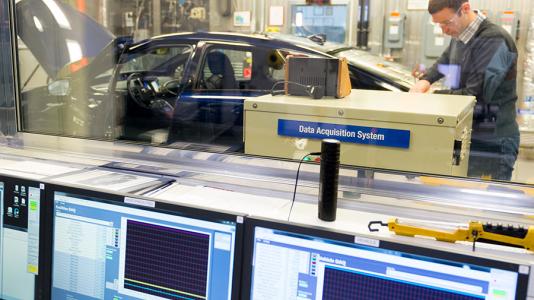
If data is the fuel for our understanding of vehicle systems, then analysis is the engine — the thing that turns data into something useful and moves us ahead, toward increasingly greater performance and innovation.
Without insightful analysis, regulators would struggle to deliver well-informed policies for consumers, and innovators would be halted from dreaming up new ways to further optimize safety, durability, and efficiency and drive down energy use and costs.
Delivering analysis that has an impact is the business of researchers at Argonne’s Center for Transportation Research (CTR). Year after year, automotive leaders and national and international stakeholders have turned to the center’s experts to generate robust data and transform it into meaningful actionable information.
Over the years, Argonne researchers have analyzed just about every type of powertrain, from electric to hybrid to diesel. Now, with the diversification of vehicle engine technologies, researchers have turned their eye to hydrogen fuel cell vehicles for a fresh look.
In their latest endeavor, researchers within the CTR have analyzed one of the first commercially available hydrogen fuel cell vehicles — the Toyota Mirai — in partnership with Transport Canada’s Innovation Centre, a Canadian federal government department responsible for transportation R&D. Their work has generated powerful new insights, the first of its kind to be made available to the public.
Argonne’s toolkit for detailed vehicle analysis
“There has been for years now an immense desire to evaluate what the operating efficiency of a production hydrogen fuel cell vehicle could be, but until recently there have not been commercially available vehicles on the market,” said Argonne research engineer Kevin Stutenberg. “Now that these vehicles are commercially available, we can leverage our testing facilities and experience to provide comprehensive, data-driven analysis.”
To test the Mirai, researchers used facilities and leading-edge instruments, including two-wheel-drive and four-wheel-drive dynamometers, a thermal chamber with a temperature range from as low as 0°F all the way to 95°F, and many other advanced testing tools.
These specialized resources enabled researchers to test the Mirai’s performance under a range of realistic operations conditions, including varying drive cycles, from rural to urban, and environmental conditions.
“The real advantage of doing this work at Argonne is not the data that it produces, but rather our ability to provide significantly more robust insights on how vehicle systems operate,” Stutenberg said. “We not only study the overall system, we investigate specific components — including electric motors, energy storage and all the accessories that make a vehicle function — to analyze and deliver a detailed understanding of how these parts interact.”
Sharing knowledge to advance R&D
The lab’s holistic approach to measuring and analyzing the Mirai’s performance has generated rich findings that will be made publicly available. They can be used by researchers and other stakeholders to advance R&D in the field, including improving models of fuel cell technologies such as Argonne’s own Autonomie powertrain software. These findings can also be used compare with existing or emerging technologies, such as electric and hybrid electric vehicles.
“There’s plenty of data on hydrogen fuel cells available from lab-bench experiments, dealing with materials and flow paths, and innovations around them, but to my knowledge, this is the first full data set of a fuel cell system operating within a car that is being made publicly available,” Stutenberg said.
Reliable, unbiased insights in a time of change
These insights come at a critical time in the history of fuel cell vehicles technologies, when sales and investment in fuel cell vehicle technologies are just starting to making headway. To date, over 6,000 fuel cell vehicles have been sold globally, with over 3,800 sold in the United States alone. U.S. sales stem from California, a state that’s investing millions in the creation of fueling stations in Los Angeles and San Francisco and the interstate highways connecting them.
“To understand where fuel cell vehicles will go from here requires an unbiased understanding of their performance, and of how well it meets consumer expectations,” said chemist Ted Krause, Laboratory Program Manager for Fuel Cell Research at Argonne.
“Consumers have been raised on the internal combustion engine and based on that,” Krause says. “They’ve come to expect certain levels of performance, with respect to acceleration, range, time it takes to refuel, and other key indicators. They not only want to know ‘Do these vehicles perform as the manufacturer touts?’ They also want to know ‘Can I expect a similar range of performance based on what I’m used to?’ The independent analysis Argonne provides delivers clearer insights on whether those expectations are being met.”
Vehicle testing and analysis was funded by the U.S. Department of Energy’s Fuel Cell Technologies Office and was done in collaboration with Transport Canada’s Innovation Centre.